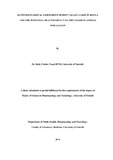| dc.description.abstract | The Kenyan Rift Valley lakes which include; lakes Elementaita, Nakuru, Oloidien and
Crater are located in Nakuru County. The lakes host a large number of the Greater
Flamingo (Phoeniconaias roseus), Lesser Flamingo (Phoeniconaias minor), Great
White Pelican (Pelecanusono crotalus) and other water birds. The Lesser Flamingo
congregate in vast numbers at certain times in these lakes creating major tourist
attraction sites which contributes significantly to the Gross Domestic Product (GDP) of
Kenya. Lesser flamingos have been classified as near-threatened due to their declining
population. In recent years, there have been massive die-offs, particularly within the
Lesser Flamingo population; the most recent occurred towards the end of 2013. These
mass deaths have been attributed to diverse causes that either relate to the availability of
food for flamingos as influenced by the salinity or toxicology of the lake waters or
direct impacts upon the birds’ population. The exact cause(s) of the deaths have not
been conclusively established. Environmental pollution may be a contributing factor to
the die offs. This study aimed at assessing the levels of fluoride and metals which
included lead, cadmium, chromium and arsenic with the aim of establishing whether
they have detrimental health impact on the birds’ population directly or indirectly. This
was an eco-toxicological assessment of the above lakes. The methodology involved
collection of water samples (n=40), sediments samples (n=51) for ecotoxicological
analysis. Live and dead Lesser Flamingos (n= 6; n=2, respectively) opportunistically
collected from the lakes were also sampled. Live birds were clinically examined in the
field and then euthanized for post-mortem examination. Analysis of samples for
fluoride was done by use of Orion fluoride meter model EIA 940. Lead, arsenic,
cadmium and chromium were analysed using Graphite Furnace Atomic Absorption
Spectrophotometer (GFAAS) model-Specter AA-10 Varian. The data was entered in
excel work sheet and analysed using ―Instat +‖ computer statistical package. The results
of the toxicological study showed that the mean concentration (±SD) of fluoride in
water samples were 55 ± 28.87, 30.75 ± 2.99, 116.9 ± 70.25, 247.9 ± 170.4 ppm for
lakes Crater, Oloidien, Elementaita and Nakuru, respectively. The high fluoride levels
in Lake Nakuru could be attributed to the relatively high contribution from rivers with a
mean of 19.25 ± 16.26 ppm and Nakuru town sewerage (6.5 ± 0.58 ppm) in addition to
the natural leachate from volcanic soil, sediment and other lakes. However this fluoride
concentration in water and soil sediments differed significantly (P< 0.05) between
lakes. Mean fluoride concentration in the tissues of birds varied significantly (p< 0.05)
from 122.5 ± 40.93 ppm in the bones, 3.12 ± 2.45 ppm in the skin and 0.40 ± 0.21 ppm
in the muscle. These concentrations were positively correlated with soil fluoride levels.
Lead and arsenic were found to be in high concentration in soil sediments in all four
lakes while chromium and cadmium were in low concentration. The concentration
(±SD) of lead in the soil sediments were 212.5 ± 44.25, 567.3 ± 46.12, 430.1 ± 122.1,
273.7 ± 67.12 ppb while that of arsenic were 409.3 ± 243.9, 512 ± 66.96, 354.4 ± 294.9,
265.5 ± 290.8 ppb for lakes Crater, Elementaita, Nakuru and Oloidien, respectively.
Soil sediments analysed from the inflow of the Nakuru sewerage drain (1754 ± 22.81
ppb) and rivers to Lake Nakuru (1129 ± 107 ppb) had the highest concentration of lead.
The concentration (±SD) of lead in the flamingo tissues were 11.09 ± 22.69, 141.6 ±
37.45, 1.89 ± 1.89, 17.36 ± 21.67, 24.59 ± 30.79, 16.68 ± 8.83, 13.9 ± 8.54 ppb while
that of arsenic were 10.2 ± 2.72, 6.82 ± 2.57, 5.24 ± 2.27, 10.43 ± 3.25, 19.12 ± 4.68,
16.92 ± 6.1, 12.45 ± 3.87 ppb for muscle, bone, brain, heart, kidney, liver and lungs,
respectively. Arsenic, cadmium, chromium and lead were also observed in bird tissues.
Metals in the Lesser Flamingo tissues were below the toxicological levels that are
reported in literature to be harmful, except lead which was above the level recommended by the US Environmental Protection Agency. It was concluded from the
results that the toxicants detected were not the main cause of the die-offs and other
factors may be involved. It is recommended that more data should be collected in order
to conclusively determine the cause of the die-offs and population decline in the Lesser
Flamingo. | en_US |
| dc.description.department | a
Department of Psychiatry, University of Nairobi, ; bDepartment of Mental Health, School of Medicine,
Moi University, Eldoret, Kenya | |

